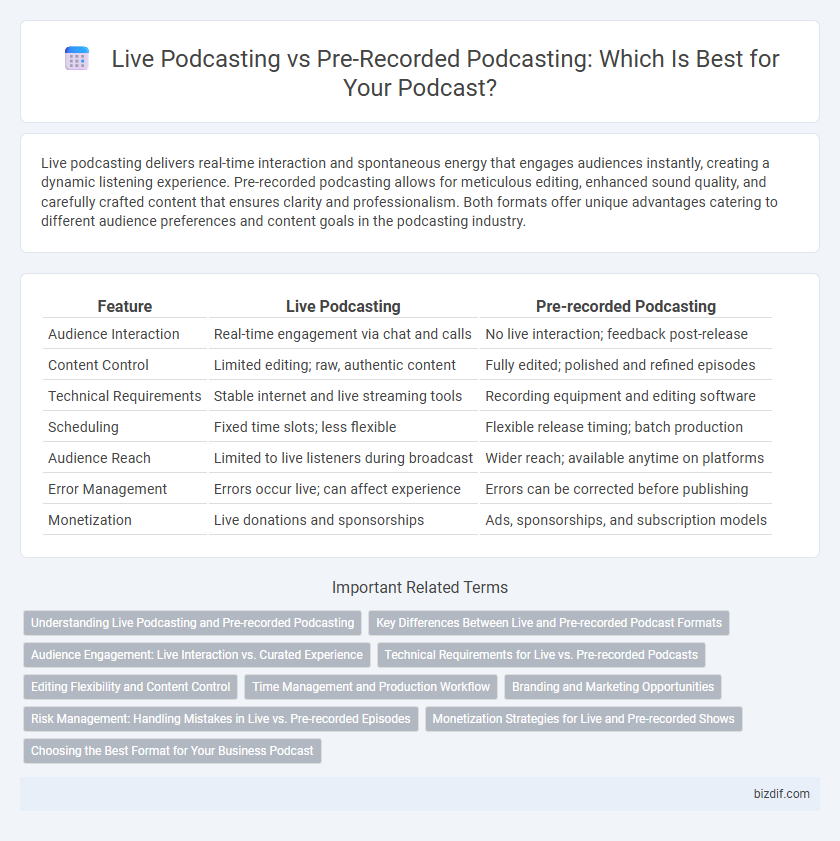Live podcasting delivers real-time interaction and spontaneous energy that engages audiences instantly, creating a dynamic listening experience. Pre-recorded podcasting allows for meticulous editing, enhanced sound quality, and carefully crafted content that ensures clarity and professionalism. Both formats offer unique advantages catering to different audience preferences and content goals in the podcasting industry.
Table of Comparison
| Feature | Live Podcasting | Pre-recorded Podcasting |
|---|---|---|
| Audience Interaction | Real-time engagement via chat and calls | No live interaction; feedback post-release |
| Content Control | Limited editing; raw, authentic content | Fully edited; polished and refined episodes |
| Technical Requirements | Stable internet and live streaming tools | Recording equipment and editing software |
| Scheduling | Fixed time slots; less flexible | Flexible release timing; batch production |
| Audience Reach | Limited to live listeners during broadcast | Wider reach; available anytime on platforms |
| Error Management | Errors occur live; can affect experience | Errors can be corrected before publishing |
| Monetization | Live donations and sponsorships | Ads, sponsorships, and subscription models |
Understanding Live Podcasting and Pre-recorded Podcasting
Live podcasting delivers real-time audience interaction and spontaneous content, enhancing engagement through immediate feedback and dynamic conversations. Pre-recorded podcasting allows meticulous editing, refined sound quality, and structured storytelling, ensuring a polished and error-free listening experience. Both formats serve unique purposes, with live podcasts fostering community connection and pre-recorded episodes enabling detailed production control.
Key Differences Between Live and Pre-recorded Podcast Formats
Live podcasting offers real-time interaction with the audience, creating an engaging and dynamic experience through immediate feedback and spontaneous content adjustments. Pre-recorded podcasting allows for meticulous editing, sound quality enhancement, and content refinement to ensure a polished final product. Key differences include audience engagement timing, production control, and flexibility in content delivery.
Audience Engagement: Live Interaction vs. Curated Experience
Live podcasting fosters spontaneous audience engagement through real-time interaction via chat, call-ins, or social media, creating a dynamic and immersive experience. Pre-recorded podcasting offers a curated, polished narrative that ensures consistent audio quality and thoughtful content editing, enhancing listener satisfaction. Audience engagement in live formats thrives on immediacy and participation, whereas pre-recorded episodes prioritize structured storytelling and refined production.
Technical Requirements for Live vs. Pre-recorded Podcasts
Live podcasting demands real-time audio capture and robust streaming infrastructure to prevent latency and ensure seamless listener experience, often requiring high-quality microphones, stable internet connections, and reliable broadcasting software. Pre-recorded podcasts benefit from advanced editing tools, noise reduction technology, and flexible publishing schedules, allowing creators to enhance audio quality and correct errors before release. Both formats rely on essential equipment like USB microphones and audio interfaces, but live podcasts emphasize immediate technical stability whereas pre-recorded podcasts focus on post-production refinement.
Editing Flexibility and Content Control
Pre-recorded podcasting offers extensive editing flexibility, allowing creators to refine audio quality, remove mistakes, and enhance listener experience through post-production techniques. Live podcasting limits content control as episodes are broadcast in real-time, increasing risks of errors and reducing opportunities for correction or improvement. Creators prioritizing polished, error-free episodes often prefer pre-recorded formats for the superior ability to shape and control content before release.
Time Management and Production Workflow
Live podcasting demands real-time coordination and swift decision-making, often limiting post-production edits but enhancing spontaneity and listener engagement. Pre-recorded podcasting allows comprehensive time management with flexible recording schedules and meticulous editing, resulting in polished content and controlled delivery. Efficient production workflow in live podcasts revolves around immediate setup and error handling, whereas pre-recorded formats benefit from segmented recording, refined editing, and scheduled releases.
Branding and Marketing Opportunities
Live podcasting offers real-time audience interaction that enhances brand engagement and creates unique marketing moments, fostering a sense of community and immediacy. Pre-recorded podcasting allows for polished content with strategic editing and optimized messaging, providing consistent brand representation and easier integration of targeted advertisements. Both formats enable tailored marketing strategies, but live podcasts excel in generating spontaneous brand loyalty, while pre-recorded episodes support scalable, repeatable promotional campaigns.
Risk Management: Handling Mistakes in Live vs. Pre-recorded Episodes
Live podcasting involves higher risk exposure due to the inability to edit or remove errors in real-time, potentially impacting audience perception and brand reputation. Pre-recorded podcasting allows for comprehensive editing and quality control, reducing the chance of mistakes reaching listeners and enabling corrections prior to publication. Effective risk management in podcasting hinges on the choice between real-time authenticity and post-production precision to balance engagement with error mitigation.
Monetization Strategies for Live and Pre-recorded Shows
Live podcasting offers real-time audience interaction, which enhances engagement and creates unique opportunities for monetization through live donations, exclusive live event ticket sales, and dynamic ad placements tailored to immediate listener feedback. Pre-recorded podcasts maximize revenue potential by enabling precise editing and scripting to optimize sponsor message integration, offering on-demand ads, and creating evergreen content for long-term sponsorship deals. Both formats benefit from diversified income streams, but live shows capitalize on immediacy and exclusivity while pre-recorded shows rely on scalability and controlled content delivery for monetization.
Choosing the Best Format for Your Business Podcast
Live podcasting fosters real-time audience engagement and dynamic interaction, making it ideal for businesses aiming to build immediate connections and trust. Pre-recorded podcasting allows meticulous editing and content control, ensuring polished episodes that effectively communicate brand messaging and maintain consistent quality. Selecting the best format depends on your business goals, audience preferences, and resources available for production and post-processing.
Live podcasting vs Pre-recorded podcasting Infographic

 bizdif.com
bizdif.com